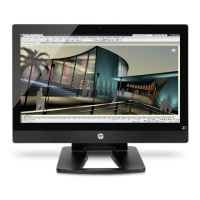Solving hard drive problems
Table 4-2 Hard drive problems
Problem Cause Solution
Hard drive error
occurs.
Hard disk has bad
sectors or has failed.
Locate and block the usage of bad sectors. If necessary, reformat the
hard disk.
If the drive is detected by the UEFI, run DPS Self-test.
Hard drive transaction
problem.
The directory structure is
bad, or there is a
problem with a file.
1. Right-click Start, select Explore, and select a drive.
2. Select File > Properties > Tools.
3. Under Error-checking, select Check Now.
Drive not found
(identified).
Improper cable
connection
On computers with discreet data and power cables, ensure that the
data and power cables are securely connected to the hard drive. (See
the Hard drive section of this guide for connection details.)
Improperly seated hard
drive
On systems with blind-mate drive connections, check for connector
damage on the drive and in the chassis.
Reseat the hard drive and its carrier in the chassis to ensure a proper
connection. (See the Hard drive section of this guide for connection
details.)
The system might not
have automatically
recognized a newly
installed device.
1. Run Computer Setup (F10) Utility.
2. If the system does not recognize the new device, verify that the
device is listed in the Computer Setup (F10) Utility.
If it is listed, the probable cause is a driver problem. If it is not
listed, the probable cause is a hardware problem.
3. If this drive is newly installed, enter Setup and try adding a
POST delay under Advanced>Power-On.
Drive responds slowly
immediately after
power-up.
Run the Computer Setup (F10) utility, and increase the POST Delay in
Advanced>Power-On Options.
Troubleshooting scenarios and solutions
65

